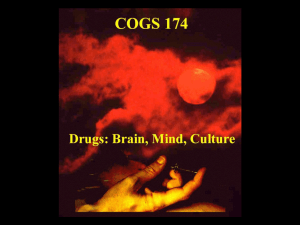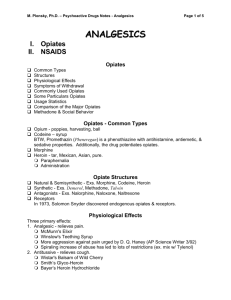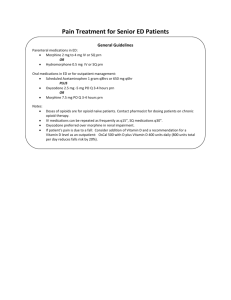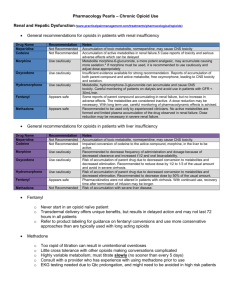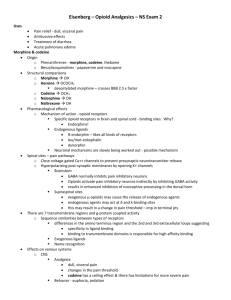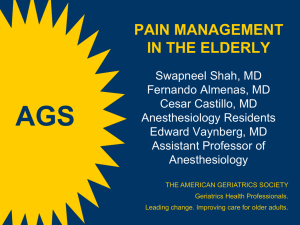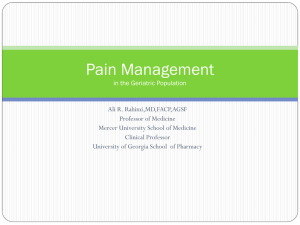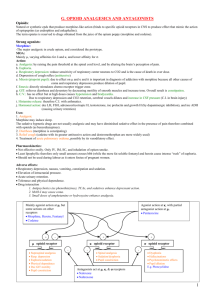Pharmacology 14a – Opiates and Opioids
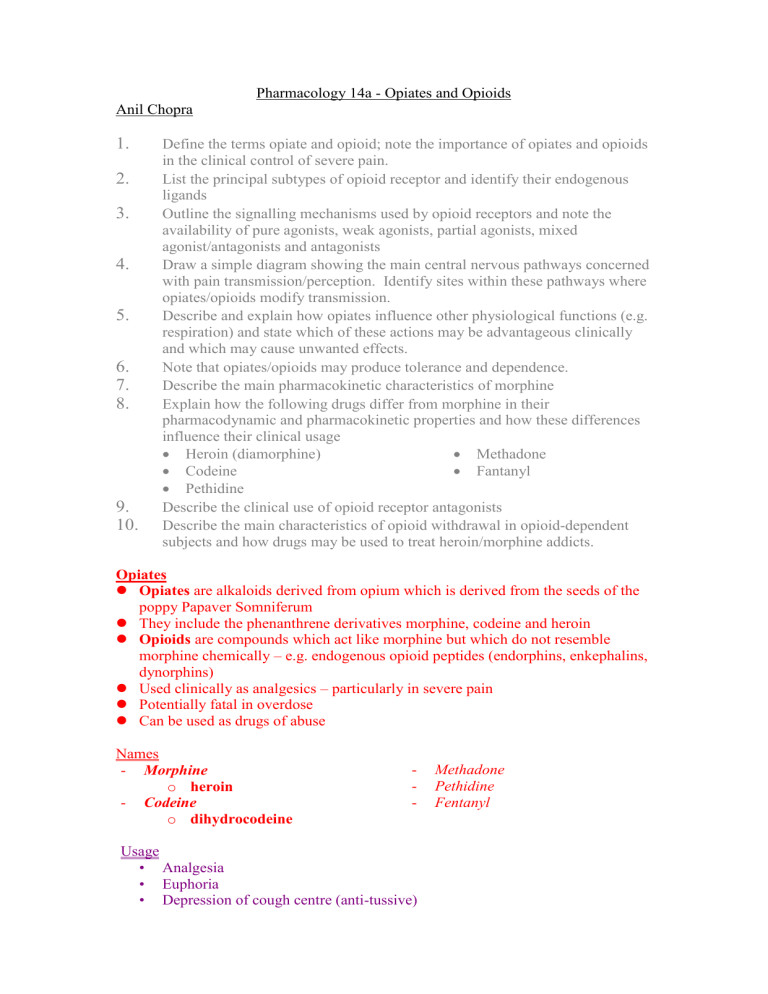
Pharmacology 14a - Opiates and Opioids
Anil Chopra
1.
Define the terms opiate and opioid; note the importance of opiates and opioids in the clinical control of severe pain.
2.
List the principal subtypes of opioid receptor and identify their endogenous ligands
3.
Outline the signalling mechanisms used by opioid receptors and note the availability of pure agonists, weak agonists, partial agonists, mixed agonist/antagonists and antagonists
4.
Draw a simple diagram showing the main central nervous pathways concerned with pain transmission/perception. Identify sites within these pathways where opiates/opioids modify transmission.
5.
Describe and explain how opiates influence other physiological functions (e.g. respiration) and state which of these actions may be advantageous clinically and which may cause unwanted effects.
6.
Note that opiates/opioids may produce tolerance and dependence.
7.
Describe the main pharmacokinetic characteristics of morphine
8.
Explain how the following drugs differ from morphine in their pharmacodynamic and pharmacokinetic properties and how these differences influence their clinical usage
Heroin (diamorphine)
Codeine
Pethidine
Methadone
Fantanyl
9.
Describe the clinical use of opioid receptor antagonists
10.
Describe the main characteristics of opioid withdrawal in opioid-dependent subjects and how drugs may be used to treat heroin/morphine addicts.
Opiates
Opiates are alkaloids derived from opium which is derived from the seeds of the poppy Papaver Somniferum
They include the phenanthrene derivatives morphine, codeine and heroin
Opioids are compounds which act like morphine but which do not resemble morphine chemically – e.g. endogenous opioid peptides (endorphins, enkephalins, dynorphins)
Used clinically as analgesics – particularly in severe pain
Potentially fatal in overdose
Can be used as drugs of abuse
Names
Morphine o heroin
Codeine o dihydrocodeine
Usage
•
Analgesia
•
Euphoria
•
Depression of cough centre (anti-tussive)
Methadone
Pethidine
Fentanyl
Mode of Action
Opioids act via specific opioid receptors :
Found mainly in the CNS
G-Protein coupled: receptor activation causes reduced exocytosis
inhibitory.
There are 3 types μ, δ and κ.
Opioids cause the release of certain endogenous peptides μ such as endorphins, enkephalins, dynorphins/ neoendorphins.
Analgesia
δ
+++ +
These peptides can then act a number of different receptors to bring about the effects of euphoria:
Endorphins - Mu μ or delta δ receptors in the cortex,
Resp Dep ++ ++
κ
++
-
GI ++ ++ + thalamus, spinal cord and peri-aqueductal grey
Enkephalins – delta δ receptors in the amygdala, deep cortex and pontine nucleus.
Dynorphins – kappa κ receptors in the hippocampus, peri-aqueductal grey, claustrum, and spinal cord.
Euphoria
Dysphoria
Dependence
+++
-
+++
-
-
-
-
+++
++
Morphine, heroin, codeine and methadone are all agonists.
They work as cell depressants which hyperpolarise the cell via an increase in cellular
K
+
ions. This results in a decreased inward current for Ca
2+
ions which stops the firing of action potentials. This makes opiates useful as analgesics which decrease pain perception and increase pain tolerance.
NRPG - Nucleus Reticularis
Paragigantocellularis
NRM – Nucleus Raphe Magnus
PAG – peri-aqueductal Grey matter
LC – locus coeruleus
It also acts on the cough centre in the larynx to suppress coughing.
(laryngeal nerves).
It does however cause respiratory depression because of its effect on chemoreceptors in the medulla as well as nausea and vomiting.
It also stimulates μ and κ receptors in the oculomotor nucleus causing miosis (pupil construction)
Because it causes a decrease in ACh, VIP (vasoactive intestinal peptide) and nitric oxide release in the enteric nervous system it has a number of GI side effects.
Other pharmacological actions of opioids:
Respiratory depression – via the medulla
Sedation
Euphoria – helps increased pain tolerance. An indirect response due to inhibition of GABA release
Dysphoria – opposite of euphoria
Depression of cough reflex – via depression of cough centre (anti-tussive)
Pupil constriction (miosis) – via stimulation of oculomotor nucleus
Stimulation of chemoreceptor trigger zone – nausea and vomiting
GI tract: - constipation
Reduced gastric emptying
Reduced motility
Increased water reabsorption
Decrease in BP – due to increased histamine release and medullary suppression
Side effects and Pharmacokinetics
It is thought that tissue tolerance is brought about by the gene beta-arrestin 2 which causes desensitisation of G-protein coupled receptors in the nervous system.
They also have great problems in those who frequently use them because dependence can be built. This is mainly in the locus coeruleus and manifests itself as a psychological craving for the drugs along with a physiological pathology (flu-like symptoms).
They are metabolised by the liver (cytochrome p450) and excreted in the urine.
Side Effects
Depression of respiration (medulla)
Stimulation of chemoreceptor trigger zone (nausea/vomiting)
Pupillary Constriction
G.I. Effects o Decrease in gastric emptying o Decrease in G.I motility o Increase in water absorption o Constipation
Overdose o Coma o Respiratory depression o Pin-point pupils o Hypotension o Treatment: Naloxone (opioid antagonist) i.v.
Pharmacokinetics
Acute or chronic pain – only severe pain
Administration – oral (high first pass metabolism), IM or IV
Wide distribution
Metabolism – hepatic conjugation
Duration of action – 3-6hrs
Differences Between Opioids
Heroin:
Also known as diamorphine (medically)
Acetylated morphine
Similar to morphine but:
Enters the brain more quickly (more lipid soluble) – greater rush
Shorter duration of action
Codeine:
3-methyl-morphine
A weak analgesic – used for weak pain
Anti-tussive (suppresses cough) at sub-therapeutic doses
A partial opioid receptor agonist
Orally given – converted to morphine (active component) in the liver
Causes severe constipation
Pethidine:
meperidone
Weak opioid receptor agonist – more powerful than codeine
Used in obstetrics – excreted without conjugation so can be given to mothers in labour as babies can excrete it (small children/foetuses cannot conjugate morphine for excretion
Generally given orally or IM
Methadone:
Weak agonist
Little euphoric action
Effective orally
Long duration of action – 24hrs
Used in chronic pain and substitution therapy for addicts
Fantanyl:
Highly potent µ selective
Shot acting
Administered IV, epidurally or transdermally
Used mainly in anaesthesia (intra-thecally) and in acute pain
Symptoms and treatment of withdrawal
Withdrawal is characterised by:
Craving
Yawning
Sweating
Gooseflech
Tremor
Irritability
Anorexia
Nausea and vomitting
Long term substitution therapy with methadone is used – gradually decreasing the dose.
Methadone does not cause the euphoric effects on other opiates

